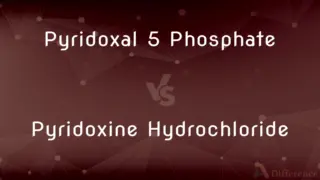SDS Page vs. Native Page — What's the Difference?
Edited by Tayyaba Rehman — By Maham Liaqat — Published on February 21, 2024
SDS-PAGE denatures proteins and separates them by molecular weight, while Native PAGE maintains protein structure and separates based on charge and size.

Difference Between SDS Page and Native Page
Table of Contents
ADVERTISEMENT
Key Differences
SDS-PAGE (Sodium Dodecyl Sulfate Polyacrylamide Gel Electrophoresis) is a technique that denatures proteins and binds SDS to them, imparting a negative charge proportional to their size. This process ensures that proteins are separated in the gel based solely on their molecular weight. In contrast, Native PAGE (Polyacrylamide Gel Electrophoresis) preserves the protein's native structure and functional state during separation. This method allows proteins to migrate through the gel based on their native charge, size, and shape.
In SDS-PAGE, the SDS detergent disrupts secondary, tertiary, and quaternary protein structures, leading to the linearization of proteins. This uniform negative charge masks the protein's original charge, allowing for an accurate estimation of molecular weight. Native PAGE, however, maintains the protein's complex structure, which means that the migration speed through the gel can be influenced by the protein's shape and charge as well as its size.
SDS-PAGE is widely used for determining the purity of protein samples, estimating molecular weights, and preparing samples for further analysis like mass spectrometry. Native PAGE is preferred for studying protein-protein interactions, enzyme activities, and for isolating functional protein complexes due to its non-denaturing conditions.
The choice between SDS-PAGE and Native PAGE depends on the goal of the experiment. SDS-PAGE provides clear information about protein size, which is essential for identifying and characterizing proteins. Native PAGE, on the other hand, is invaluable for analyzing the biological function of proteins in their native state.
While SDS-PAGE offers a straightforward and reproducible way to analyze protein size, it cannot provide insights into the protein's functional state or its interactions with other molecules. Native PAGE, despite its ability to preserve protein function, may result in less clear separation of proteins due to the variable influence of shape and charge on migration.
ADVERTISEMENT
Comparison Chart
Denaturation
Yes, uses SDS to denature proteins
No, maintains native conformation
Charge Source
SDS provides uniform negative charge
Native charge of the protein
Separation Basis
Molecular weight
Charge, size, and shape
Protein Structure
Denatured and linearized
Native and functional
Main Use
Molecular weight estimation, protein purity analysis
Studying protein interactions, enzyme activity
Compare with Definitions
SDS Page
Allows for the comparison of protein samples.
Researchers compared the expression levels of a protein in diseased vs. healthy tissue using SDS-PAGE.
Native Page
Provides insights into protein conformation.
Native PAGE helped in comparing the conformational changes of a protein under different conditions.
SDS Page
Essential for protein characterization.
SDS-PAGE helped in identifying potential candidates for further mass spectrometry analysis.
Native Page
Separates proteins based on natural charge and size.
Enzyme complexes were resolved using Native PAGE to assess their functional assembly.
SDS Page
Commonly used in molecular biology and biochemistry.
SDS-PAGE is a staple technique for analyzing protein samples in research labs.
Native Page
Can be used to assess protein activity.
The enzymatic activity of proteins was tested directly on a Native PAGE gel.
SDS Page
A method for separating proteins by size using SDS.
SDS-PAGE was used to estimate the molecular weight of purified enzymes.
Native Page
Electrophoresis that maintains the protein's native state.
Native PAGE was used to study the oligomeric state of a membrane protein.
SDS Page
Denatures proteins for uniform charge distribution.
The denaturing effect of SDS in SDS-PAGE ensures proteins are separated solely by size.
Native Page
Useful for analyzing protein-protein interactions.
Native PAGE facilitated the observation of a transient protein complex involved in DNA repair.
Common Curiosities
How does SDS-PAGE work?
In SDS-PAGE, SDS detergent denatures proteins and binds to them, giving them a uniform negative charge and allowing separation by size.
What is SDS-PAGE?
SDS-PAGE is a denaturing gel electrophoresis technique used to separate proteins based on their molecular weight.
What is the main advantage of Native PAGE over SDS-PAGE?
The main advantage of Native PAGE is its ability to maintain the native state of proteins, allowing for the analysis of protein interactions and activities.
Can SDS-PAGE be used to study protein-protein interactions?
SDS-PAGE is not ideal for studying protein-protein interactions because it denatures proteins, disrupting their native interactions.
How do proteins migrate in SDS-PAGE?
In SDS-PAGE, proteins migrate through the gel matrix based on size, with smaller proteins moving faster.
Can Native PAGE be used for all types of proteins?
Native PAGE is suitable for most proteins, but its effectiveness can vary depending on the protein's size, charge, and shape.
What role does SDS play in SDS-PAGE?
SDS denatures proteins and imparts a uniform negative charge, ensuring separation is based on size alone.
How are proteins prepared for SDS-PAGE?
Proteins are mixed with a sample buffer containing SDS and a reducing agent, then heated to denature them before loading onto the gel.
What is the purpose of the gel in these techniques?
The gel acts as a sieve, allowing smaller proteins to move faster than larger ones in SDS-PAGE, and separates proteins based on their native properties in Native PAGE.
Is Native PAGE suitable for estimating molecular weight?
Native PAGE is less suitable for estimating molecular weight accurately due to the variable influence of protein shape and charge on migration.
What is Native PAGE?
Native PAGE is an electrophoresis method that separates proteins under non-denaturing conditions, preserving their native structure and function.
Are there limitations to Native PAGE?
Native PAGE's resolution can be affected by the native charge and shape of proteins, potentially complicating the separation of complex mixtures.
How does the buffer system differ between SDS-PAGE and Native PAGE?
SDS-PAGE uses a buffer system that maintains the pH and ionic strength conducive to denaturation, while Native PAGE buffers are designed to preserve protein structure.
What detection methods are used after SDS-PAGE or Native PAGE?
Common detection methods include staining with Coomassie Blue or silver stain, and western blotting for specific protein identification.
Can these techniques be scaled for high-throughput analysis?
Both SDS-PAGE and Native PAGE can be adapted for high-throughput settings, though automation and miniaturization may be required for efficient processing.
Share Your Discovery

Previous Comparison
Calciferol vs. Cholecalciferol
Next Comparison
Pyridoxal 5 Phosphate vs. Pyridoxine HydrochlorideAuthor Spotlight
Written by
Maham LiaqatEdited by
Tayyaba RehmanTayyaba Rehman is a distinguished writer, currently serving as a primary contributor to askdifference.com. As a researcher in semantics and etymology, Tayyaba's passion for the complexity of languages and their distinctions has found a perfect home on the platform. Tayyaba delves into the intricacies of language, distinguishing between commonly confused words and phrases, thereby providing clarity for readers worldwide.
















































